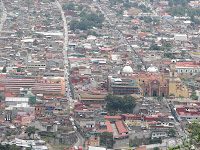
(Note: this should have been posted around September 16, 2011.)
Puebla, Mexico
After checking into Casa de Palma and having a rest, we headed out into the drizzly night in search of English books. We've been dying for them, feeling like nomadic people lost in a desert without water. The desk clerk stopped us and offered us a paragua (umbrella), which is such a sensible word; literally "for water."
With paragua in hand, we marched up the cobblestone streets, admiring the 16th, 17th, and 18th century architecture. With the celebration of Miguel Hidalgo's fiery revolutionary speech set to take place at midnight, the streets were alight with glittery banners and the happy faces of thousands of Mexicans ready to honor the forefathers who helped liberate their country from Spain.
We were on a high, with all the happy expectations of at last refreshing our small library! Alas, the store was closed. We asked directions and trekked off to the next possible store. It too was closed, but there was another a half block away, just outside the security zone. We didn't hesitate. Doors locked. Drat! One more ... we trekked another half mile. Although it was closed, we'd left our bread crumbs so we'd know how to find the stores in the morning.
We headed back towards the zocalo (town square in colonial towns, usually green parks bordered by the cathedral and city hall or government palace). Oops! No paraguas allowed past the security scanners when returning to the town center. Chagrined, we both knew we had to make the best effort to return the hotel's generously loaned umbrella. Off we went, hiking the extra mile or so to skirt the security perimeter so we would come up next to the entrance point closest to our hotel. (You may recall there was a battalion of armed officers parked under the windows just outside our hotel.) We figured if we got that far, one of us could go through the checkpoint and get the hotel desk clerk, who could plead the case for their umbrella.
It worked! It only took us about an extra 90 minutes, but we restored the paragua and established goodwill. Then, hungry, we headed off for a late dinner at a recommended restaurant bordering the zocalo.
Exhausted and satisfied by a simple, Mexican (delicious, or riccissimo) dinner, we collapsed into our comfortable bed long before the midnight celebrations began. We awoke, though, to fireworks and revelry. All across the country, Mexicans were celebrating El Grito de Dolores, the speech of Miguel Hidalgo, which served as a spark for revolution in 1810. (More here: http://www.sanmiguelguide.com/tour-el-grito.htm)
Refreshed by sleep, we set forth in the morning hoping for books the way a fisherman hopes for results. Alas, the only English books we could find were language instruction texts, and those, while tempting for Celeste, were very expensive. Books generally are, in Mexico; something Celeste hopes will change with the digital book revolution.
Fortunately, we had something else to look forward to: a trip to Cholula, which boasts the world's second largest pyramid. Undaunted, we headed for the bus terminal to continue the adventure.






































